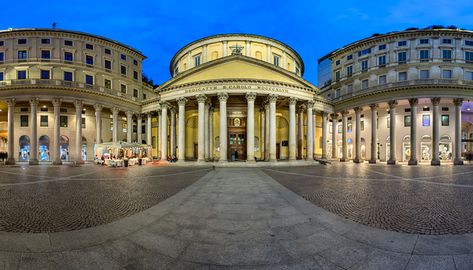

Inspired by the Pantheon in Rome, the Church of Saint Charles was built between 1832 and 1847 in the neo-classical style. Its author was an architect from the nearby town of Monza, Carlo Amati, who at that time also completed the façade of the Duomo. The church was built as a token of gratitude to the Madonna for ending a cholera epidemic that had devastated the city. It was dedicated to Saint Carlo Borromeo, the leading proponent of the Counter Reformation who was also Bishop of Milan in the 16th-century during a deadly plague.
The Church of St Charles replaced a small 13th-century convent belonging to the Servite Order, a mendicant confraternity that preaches the Gospels, laying particular emphasis on the role of the Virgin Mary as the Mother of God. In 1938 Pope Pius XI gave the church the status of a Minor Basilica, thus augmenting its religious authority. The Servite Order still manages the church today.
The church's most striking external element is the trilateral colonnade that extends to Corso Vittorio Emanuele, creating an elegant square that often serves as a shady retreat during the muggy summers. The colonnade consists of 36 granite Corinthian columns and has two side porticos and a central one, which in aesthetic terms blend perfectly with the 20th-century arcades of the buildings on Corso Vittorio Emanuele. As the Pantheon in Rome the central portico contains eight columns that support a triangular pediment, on top of which two marble angels hold up a bronze cross. The gigantic but low dome rests on a cylindrical structure that is adorned with semi-columns, windows and niches, while the lantern pinnacle on its very top is surrounded by angelic caryatids. Behind the church rises an 84-meter-high bell tower, the highest bell tower in the city.
The church's round interior also draws its inspiration from the Roman Pantheon. It is decorated with red granite columns and a perennially polished marble floor. The deep presbytery has its own cupola and a sumptuous high altar from the 18th century. The altar contains a marble relief of St. Carlo Borromeo Giving Communion to St. Aloysius Gonzaga sculpted by Pompeo Marchesi, student of Antonio Canova. Marchesi also created the wooden crucifix that is positioned above the altar.
Another interesting element in the church is the chapel dedicated to Blessed Giovannangelo Porro, which contains his mortal remains. Porro, a member of a 15th century aristocratic family and later monk at the Servite Order, is said to have cured Carlo Borromeo through divine intervention when the latter was a boy.
Although the Church of San Carlo as a religious institution may appear somewhat out of place in such a bustling commercial center, it is very respected by the Milanese as a venue for book presentations and chamber concerts.